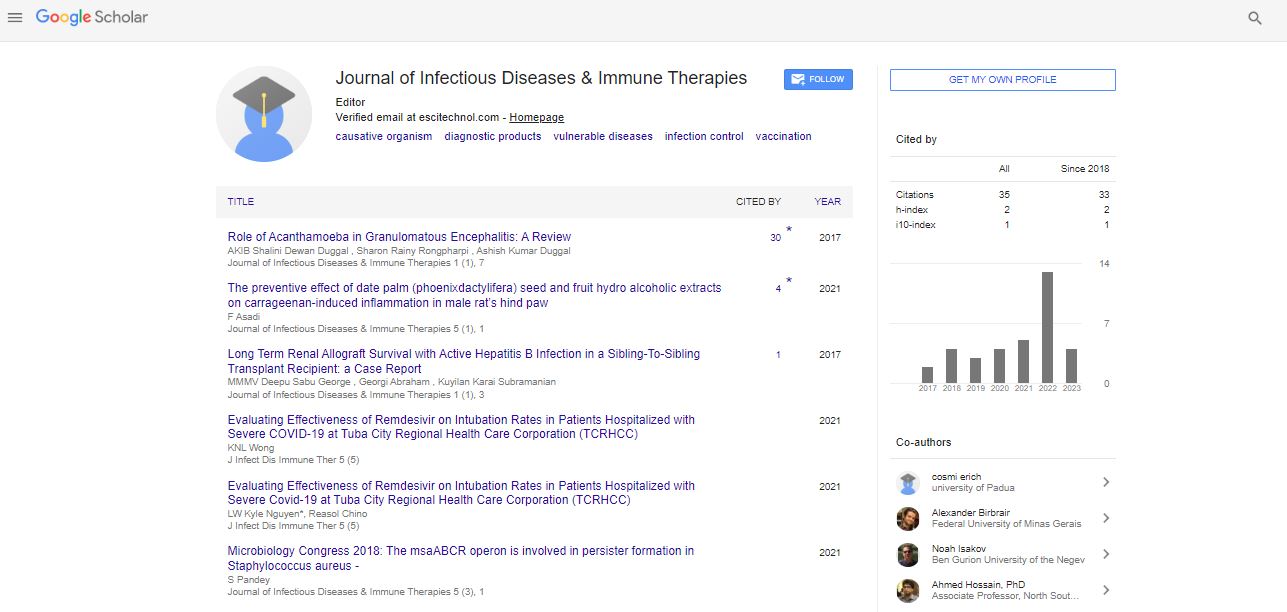Opinion Article, J Infect Dis Immune Ther Vol: 7 Issue: 1
Epstein Barr Virus: A Comprehensive Analysis on Ubiquitous Human Pathogen
Obeidat Baerg*
Department of Internal Medicine, The Jikei University School of Medicine, Tokyo, Japan
*Corresponding Author: Obeidat Baerg
Department of Internal Medicine, The Jikei University School of Medicine, Tokyo, Japan
E-mail: obeidbaerg@gmail.com
Received date: 03 February, 2023, Manuscript No. JIDITH-23-96360;
Editor assigned date: 07 February, 2023, PreQC No. JIDITH-23-96360 (PQ);
Reviewed date: 21 February, 2023, QC No. JIDITH-23-96360;
Revised date: 28 February, 2023, Manuscript No. JIDITH-23-96360 (R);
Published date: 07 March, 2023, DOI: 10.4172/JIDITH.1000159
Citation: Baerg O (2023) Epstein Barr Virus: A Comprehensive Analysis on Ubiquitous Human Pathogen. J Infect Dis Immune Ther 7:1.
Description
Epstein Barr Virus (EBV) is a member of the Herpesviridae family and is one of the most common human viruses, with a worldwide prevalence of over 90%. EBV infects B lymphocytes and epithelial cells, and is associated with a wide range of clinical manifestations, from asymptomatic infections to severe diseases, including Infectious Mononucleosis (IM), Burkett lymphoma, nasopharyngeal carcinoma, and other malignancies.
Molecular biology of EBV
EBV has a linear, double-stranded DNA genome with over 80 genes and a complex life cycle involving latent and lytic phases, with lifelong persistence in B cells, periodic reactivation into the lytic phase, production of viral particles in saliva, and expression of viral proteins during latency that contribute to immune evasion, cell proliferation, and transformation, contributing to its oncogenic potential.
Epidemiology of EBV
EBV, transmitted through oral contact with infected saliva, is highly prevalent worldwide, with most people getting infected at some point in their lives, and it is associated with symptomatic IM in adolescents and young adults, as well as malignancies in immune compromised individuals.
Clinical manifestations of EBV
EBV infection presents with variable clinical manifestations, with asymptomatic or mild symptoms in immunocompetent individuals, and symptomatic IM more common in adolescents and young adults, characterized by fever, sore throat, lymphadenopathy, and fatigue, which usually resolves spontaneously but can occasionally result in complications.
EBV is associated with various malignancies, including Burkitt lymphoma, Hodgkin lymphoma (mixed cellularity subtype), and nasopharyngeal carcinoma, particularly in endemic areas of Africa and Southeast Asia, where it accounts for a significant proportion of childhood cancers and is detected in malignant cells.
Diagnosis and management of EBV
Diagnosis of EBV infection can be achieved through laboratory methods including serology, PCR, and antigen/nucleic acid detection in tissue specimens, with serologic testing and PCR being commonly used for confirming IM or past infection and detecting EBV-associated malignancies.
There is no specific antiviral therapy for EBV and management is mainly supportive. Symptomatic treatment, such as analgesics and antipyretics, can be used to relieve the symptoms of IM. In severe cases of IM, corticosteroids may be prescribed to reduce inflammation and alleviate symptoms. However, corticosteroids should be used with caution and under the guidance of a healthcare professional, as they can have potential side effects.
Treatment options for EBV-associated malignancies vary depending on cancer type and stage, with Burkett lymphoma often treated with intensive chemotherapy, nasopharyngeal carcinoma requiring a combination of radiation therapy, chemotherapy, and targeted therapies, and adjunctive therapies like immunotherapy or antiviral drugs being considered on a case-by-case basis.
Prevention of EBV infection is challenging due to its high prevalence and modes of transmission. However, basic hygiene practices, such as regular hand washing, avoiding sharing utensils or personal items, and practicing safe sex, can help reduce the risk of EBV transmission. In addition, individuals with weakened immune systems, such as those with HIV/AIDS or undergoing immunosuppressive therapy, should take extra precautions to prevent EBV infection.
Conclusion
Epstein Barr Virus is a ubiquitous human pathogen that is associated with a wide range of clinical manifestations, from asymptomatic infections to severe diseases such as IM and various malignancies. Despite its high prevalence, there is no specific antiviral therapy for EBV, and management is mainly supportive and focused on relieving symptoms and treating associated malignancies.
 Spanish
Spanish  Chinese
Chinese  Russian
Russian  German
German  French
French  Japanese
Japanese  Portuguese
Portuguese  Hindi
Hindi 